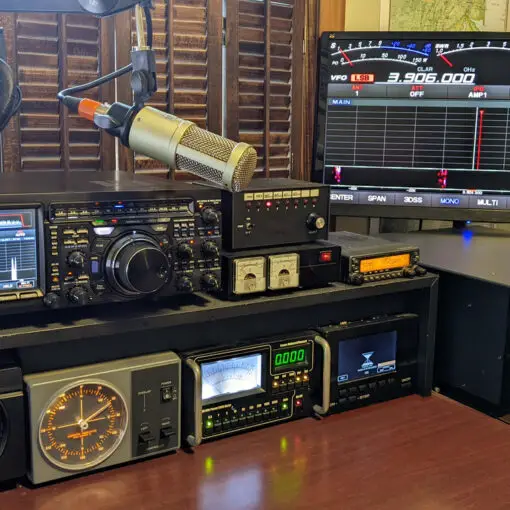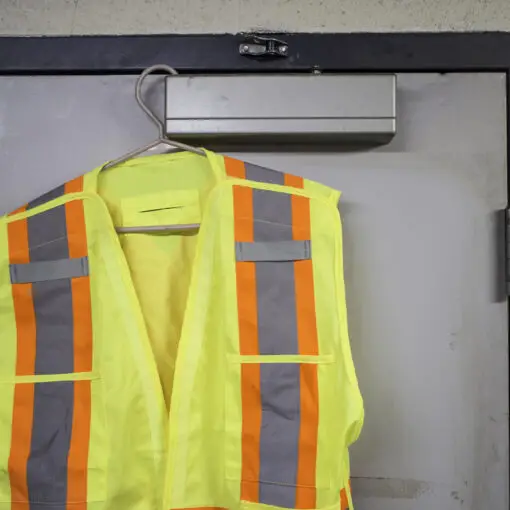Vintage ham radio brands hold a special place in the hearts of many amateur radio enthusiasts, as they represent the beginnings of the hobby and showcase the technological advancements made throughout the years. Collectors, restorers, and operators alike have a deep appreciation for these bygone radios that remind them of the ingenuity and craftsmanship of the early radio industry. These classic pieces of equipment are not only admired for their aesthetic appeal but also for their performance, often rivaling modern-day equipment in terms of quality.
Among the many well-regarded vintage brands are Conqueror (tube brand), Consolidated Radio & Television Co., and Conrad-Johnson Design, Inc. Each of these manufacturers played a key role in the development of ham radio, implementing innovations in vacuum tube technology, amplitude modulation (AM) communication, and Morse code transmission through continuous wave (CW) radiotelegraphy.
As the interest in vintage ham radio brands continues to grow, enthusiasts gain not only a deeper understanding of the history of amateur radio but also form connections with fellow hobbyists who share the same passion. Whether they are acquiring a rare radio from their favorite brand or attending a local event to discuss restoration techniques, vintage ham radio enthusiasts are preserving and celebrating the rich history of communication technology.
History of Vintage Ham Radio Brands
American Radio Relay League
The ARRL is a prominent organization in the world of vintage amateur radio. Founded in 1914, it has played a crucial role in the development and promotion of ham radio over the years. They provide resources and support to enthusiasts who are interested in restoring and operating vintage equipment, including those using vacuum tube technology.
Atwater Kent
Atwater Kent was an American radio manufacturer that produced high-quality radios and components during the 1920s and the 1930s. Known for their reliability, Atwater Kent radios were popular among amateur radio operators. Many of these vintage radios are still sought after and restored by collectors today.
Crosley
Crosley was another successful American radio manufacturer during the 1920s. Their innovative products, such as the “Harko” series, allowed many people to have access to affordable, easy-to-use radios. This helped popularize the hobby of ham radio and led to a boom in amateur radio enthusiasts. Today, Crosley vintage radios are highly desirable among collectors.
Emerson
Emerson Radio Corporation, established in 1915, was one of the early pioneers in radio production. They manufactured a wide range of radio equipment, including versatile, portable models suitable for amateur radio use. Many ham radio operators relied on Emerson radios for their durability and quality performance. Vintage Emerson radios are now cherished by collectors for their unique designs and significance in radio history.
RCA
RCA, or the Radio Corporation of America, was a major player in the radio industry, producing some of the most iconic and groundbreaking products of the early 20th century. They developed advanced radio technology, such as the superheterodyne receiver, which had a significant impact on the quality and capabilities of radios available to amateur operators. RCA vintage equipment is highly regarded by collectors, as it represents an important era in the history of radio and ham radio.
Overall, these vintage ham radio brands contributed significantly to the growth and popularity of amateur radio. Their innovative products and technologies provided users with reliable, high-quality equipment that could be used for both communication and entertainment purposes. As a result, they have left behind a legacy that continues to inspire and attract both amateur radio operators and collectors alike.
Vintage Equipment Types and Operating Modes
Vintage amateur radio equipment often reflects the technology and designs popular in their respective eras. Some iconic brands, like Collins, Hallicrafters, and Heathkit, produced various pieces of equipment, including transmitters, receivers, and transceivers. Collecting, restoring, and operating this vintage equipment is a cherished hobby for many amateur radio enthusiasts.
During the vacuum tube era, which spanned from the 1920s to the 1960s, a range of equipment was built and operated by ham radio operators. Some of the more popular types of equipment include:
- Transmitters: Heathkit DX-60, Collins 32V, and Hallicrafters HT-37
- Receivers: National NC-183D, Hammarlund HQ-129X, and Drake 2B
- Transceivers: Collins KWM-2, Hallicrafters SR-160, and Heathkit HW-101
Operating modes used with these vintage radios were often limited to amplitude modulation (AM) and continuous wave (CW) radiotelegraphy, or Morse code transmission. In AM operation, human voice information was modulated by carrier wave amplitude changes. CW operations involved the use of on/off keying of the transmitter’s carrier wave to send Morse code messages.
Some of the popular operating modes and techniques for vintage amateur radio equipment include:
- Amplitude Modulation (AM): Used for voice communications, particularly during the vacuum tube era
- Continuous Wave (CW): Morse code transmission using a series of on/off keying signals
- Single Sideband (SSB): An AM-derived mode that reduces bandwidth and power requirements, often found in later vintage equipment
- Frequency Modulation (FM): A mode more commonly used with VHF/UHF equipment, but also utilized in some vintage transceivers
Ham radio operators passionate about vintage equipment enjoy the challenge of operating these older technologies, as well as the sense of nostalgia they evoke. The attention to detail in restoring and maintaining vintage equipment also helps to preserve the history of amateur radio and connect with a bygone era.
Top Vintage Ham Radio Brands
Icom
Icom is a well-known brand in the world of vintage ham radios. Established in 1954, the company has been producing high-quality amateur radio equipment for over six decades. Renowned for their reliability and performance, Icom radios have been utilized by both hobbyists and professionals alike. Some of their most popular vintage models include the IC-730, IC-751A, and the IC-745.
Yaesu
Founded in 1959, Yaesu has been a trusted name in the amateur radio community. Yaesu’s vintage collections offer a wide range of products, from transceivers to receivers that cater to different needs and preferences. A few notable vintage Yaesu models are the FT-101, FT-227, and the FT-901 series.
Kenwood
Kenwood is another prestigious brand in the vintage ham radio market. Established in 1946, Kenwood has designed and manufactured innovative, high-performance radio equipment for amateur radio enthusiasts. Some of their prominent vintage ham radio models include the TS-430S, TS-820S, and the TS-830S.
Admiral
Admiral was a popular American electronics company, particularly known for their vintage amateur radio equipment. Although the company no longer exists, Admiral radios from the mid-20th century are still sought after by collectors and enthusiasts. Some of their noteworthy models include the Admiral 7T12 and Y2271.
General Electric
General Electric (GE) is a well-known name in the electronic industry, and their vintage ham radios are no exception. Established in 1892, GE has designed and manufactured various amateur radio devices, including transmitters and receivers. Notable vintage GE radios include the Model 2-9110A and the Model 3-5980A.
In conclusion, these top vintage ham radio brands – Icom, Yaesu, Kenwood, Admiral, and General Electric – offer a glimpse into the rich history of amateur radio communications. Collectors and enthusiasts alike appreciate the quality, performance, and nostalgic value of these iconic devices.
Restoring Vintage Ham Radios
Restoring vintage ham radios can be a rewarding hobby for enthusiasts who enjoy working with old radios and preserving their historical significance. It involves repairing and refurbishing the electronic components, as well as restoring the physical appearance of vintage equipment.
One of the first steps in the restoration process is to obtain a schematic of the radio model being restored. This is essential for understanding the circuitry and will serve as a reference throughout the project. Schematics can often be found on websites like the BoatAnchor Manual Archive (BAMA).
Next, it is important to clean and inspect the radio chassis. Most old radios require some degree of cleaning, and it is essential to carefully remove any dust and grime that may have accumulated over the years. This can be done using gentle cleaning solutions and soft, lint-free cloths.
When working on the electronic components, it is crucial to systematically approach repairs and replacements. Many vintage radios have faulty capacitors, resistors, and tubes that need to be replaced or repaired. Access to an extensive database of schematics and service data, like those found at retroradioshop.com, can be invaluable for this stage of the restoration.
In addition to repairing the electronic components, restoring the physical appearance of the radio is equally important. This may involve polishing or repainting the radio’s cabinet, replacing damaged knobs or dials, and even reupholstering the speakers.
There are several resources available online to assist with antique radio repair, such as the Antique radio repair category on DXZone.com. Additionally, joining communities of vintage radio enthusiasts can provide invaluable advice, tips, and support during the restoration process.
In conclusion, restoring vintage ham radios can be a challenging but rewarding hobby. Through patience, research, and attention to detail, enthusiasts can breathe new life into old radios and preserve their legacy for future generations.
Vintage Ham Radio Publications and Licensing
Amateur Radio License
The amateur radio license is an essential requirement for individuals who wish to operate vintage ham radios legally. To obtain a license, enthusiasts must pass an examination covering various aspects of radio theory, regulations, and operating practices. Studying and preparing for this test can involve several publications and study materials available online. These resources help aspiring amateur radio operators grasp the necessary knowledge and skills to pass the license exam and operate their equipment efficiently.
Some websites, like the Digital Library of Amateur Radio & Communications, offer vast archives of materials and collections related to amateur radio. From study guides to historical records, these resources can foster a better understanding of vintage ham radio equipment and operation techniques.
QST Magazine
One notable publication for vintage ham radio enthusiasts is the QST Magazine, a monthly journal published by the American Radio Relay League (ARRL). QST is a renowned source of information, covering everything from vintage radio restoration to current amateur radio news and developments. The magazine also features technical articles, construction projects, and product reviews, allowing readers to stay updated on the latest developments and connect with fellow vintage ham radio aficionados.
Although primarily focused on modern amateur radio operations, the QST Magazine has a history dating back to the early 20th century and often includes articles relevant to vintage equipment, addressing topics such as:
- Restoring antique radios
- Tips for maintaining vacuum tube technology
- Instructional guides for hobbyists interested in building their vintage radio systems
Overall, both the amateur radio license and publications like QST Magazine play a crucial role in the vintage ham radio community. They provide an avenue for enthusiasts to legally operate their equipment, foster connections within the community, and stay informed about the latest developments in the world of amateur radio.
Setting Up a Vintage Ham Radio Station
Setting up a vintage ham radio station is an exciting endeavor for hobbyists looking to explore the world of antique and vintage radios. This section will provide a brief guide on how to set up a station, ensuring enthusiasts can begin experimenting with their vintage equipment.
Before starting the process, it’s essential to select an appropriate location for the ham station. The chosen area should be comfortable, have access to power (preferably both 120V and 240V AC), and offer enough space for equipment and antennas1. A dedicated space within one’s home or garage is ideal.
Next, vintage ham radio enthusiasts will need to acquire the necessary equipment. This typically includes a transceiver, power supply, and antennas2. Vintage amateur radio is a subset of the amateur radio hobby where collectors often restore and preserve old radio equipment using vacuum tube technology3. Therefore, finding and restoring equipment adds another layer of enjoyment to the hobby.
Once the equipment is in place, it’s crucial to set up the antenna. For vintage ham radio stations, classic dipole antennas are a popular choice4. To set up a dipole antenna, measure the distance between two supports and cut the wire to the appropriate length4. Then, connect the dipole to the transmission line or window line by cutting the wire in half at the center and soldering the ends4.
After setting up the antenna, connect the transceiver and power supply. Ensure all connections are secure and adhere to safety guidelines. If any equipment requires repair or restoration, consult resources dedicated to vintage radio equipment to find detailed specifications, manuals, and schematics5.
In summary, setting up a vintage ham radio station involves selecting a suitable location, acquiring and restoring necessary equipment, and properly connecting antennas, transceivers, and power supplies. Following these steps, enthusiasts can enjoy the nostalgic hobby of vintage ham radio operation.
Footnotes
Vintage Ham Radio Accessories
Amplifiers
Ham radio enthusiasts enjoy exploring and collecting vintage amateur radio equipment, which often includes amplifiers. These essential accessories boost the signal strength of a transmitter, ensuring clear and strong communication over long distances. Some amplifiers are designed specifically for use with vintage ham radio transmitters, while others can be used with a variety of equipment.
There are several well-known brands offering amplifiers suitable for vintage ham radio equipment. These include:
- ICOM
- Yaesu
- Alinco
- Kenwood
In addition to amplifiers, there are other essential accessories to consider for a vintage ham radio setup, such as power supplies and antennas. These items can often be found at online retailers like Ham Radio Hut or on auction sites like eBay.
When selecting an amplifier or other accessory for your vintage radio equipment, consider factors like compatibility, ease of use, and overall quality. It is also beneficial to research reviews and resources like the ARRL Antique/Vintage Radio page to learn more about specific items and their performance capabilities.
Maintaining and upgrading vintage ham radio equipment can be a rewarding hobby, with enthusiasts often taking pride in restoring older devices to their original functionality. By investing in high-quality amplifiers and accessories, you can optimize your vintage radio setup and expand your ability to communicate with fellow ham radio operators around the world.
Vintage Ham Radio and EMP Protection
Vintage ham radio is a fascinating hobby where enthusiasts collect, restore, and operate amateur radio equipment from bygone years, such as those using vacuum tube technology. These radios often utilized amplitude modulation (AM) and Morse code communication through continuous wave (CW) radiotelegraphy.
One concern for vintage ham radio operators is the potential impact of an electromagnetic pulse (EMP) on their equipment. EMPs could originate from natural phenomena, such as solar flares, or man-made incidents, like a nuclear explosion. To protect their valuable vintage radio equipment from EMP damage, radio operators need to take some precautions.
An effective countermeasure against EMP damage is using a Faraday cage, a metallic enclosure that is able to keep out external electric fields. When storing a portable radio, it is essential to first wrap the device in a non-conductive material, such as paper, cardboard, or a plastic zip lock bag. Once the radio is wrapped, it should be placed inside the Faraday cage. A well-built Faraday cage can protect not only radios but also other electronic devices and accessories that radio amateurs may use, such as charge controllers and inverters.
For off-grid radio amateurs, protecting the entire off-grid power system from EMPs may pose additional challenges. However, solar panels are generally regarded as immune to all but the most severe EMPs, so they usually do not require additional protection.
In conclusion, vintage ham radio enthusiasts should be mindful of the potential dangers posed by EMPs to their equipment. By implementing simple protective measures like using Faraday cages and properly storing their radios, they can continue to enjoy this fascinating hobby without the fear of losing their valuable devices to an unexpected EMP event.
Collecting and Appreciating Vintage Ham Radios
Collecting and appreciating vintage ham radios has become a popular hobby for enthusiasts who enjoy exploring the history and technology of old radios. These vintage devices carry with them a nostalgic charm and provide a window into the early days of wireless communication.
One significant aspect of vintage ham radio collecting is the opportunity to restore, preserve, and operate antique radio equipment. Many collectors enjoy working on amateur radio equipment from bygone years, such as those using vacuum tube technology. Popular modes of operation include speaking over amplitude modulation (AM) and communicating using Morse code through continuous wave (CW) radiotelegraphy.
Some notable vintage ham radio brands that collectors often seek include:
- Crosley
- Emerson
- Zenith
- Hallicrafters
These brands produced radios during the 1930s and 1940s and are known for their unique designs and innovative technology for their time. It is possible to find affordable options for these brands, with some Hallicrafters radios even being available for under 100 dollars.
In addition to the radios themselves, collectors may also gather vintage accessories, manuals, and schematics to enhance their understanding and appreciation of the equipment. A great resource for this information is the BoatAnchor Manual Archive (BAMA), which offers a vast archive of manuals and reference materials for various vintage radio models.
When considering the preservation of vintage ham radios, it is crucial to store them in a safe, dry environment to protect them from damage. Proper maintenance and cleaning can help preserve the radios’ appearance and functionality, allowing collectors to enjoy their hobby in a more immersive way.
In conclusion, collecting and appreciating vintage ham radios is a rewarding hobby that can provide a unique perspective into the historical advancements of radio technology. By preserving and studying these old radios, enthusiasts can gain a deeper understanding of the ingenuity and innovation that helped shape modern communication.





